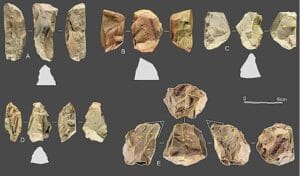Ancient Stone Tools in China Suggest Neanderthals Lived in Asia

When we think about Neanderthals, most of us picture these ancient humans surviving the harsh winters of Ice Age Europe. But what if they ventured much farther than we thought? A new discovery in China is shaking up what we thought we knew about human history — and it’s pretty fascinating stuff!
Ancient Stone Tools Uncovered in China
Recently, archaeologists discovered more than 1,400 stone tools in China’s central Hubei province. These aren’t just rocks —they’re carefully shaped tools used by ancient humans. And scientists say these tools resemble the ones made by Neanderthals in Europe over 100,000 years ago!
Now, here’s where it gets interesting: until now, there was no strong evidence that Neanderthals traveled this far east. But these tools might be the clue we’ve been missing.
What Exactly Did They Find?
The excavation, carried out in the Xiamabei cave site, uncovered:
- Over 1,400 stone tools, including scrapers and notched pieces used for cutting and shaping materials
- Tools resembling “Levallois” technology, a style strongly connected with Neanderthals in Europe and the Middle East
- Fossils of large animals, possibly hunted by these early humans
What researchers found most surprising wasn’t just the number of tools but how similar they were to Neanderthal designs — something rarely seen in East Asia.
Who Really Made These Tools?
This is the big question. Since there are no human remains at the site (yet!), no one can say for sure if Neanderthals themselves made these tools or if another group of ancient humans learned the techniques.
Could it be early Homo sapiens who picked up Neanderthal methods? Or did Neanderthals make it all the way to central China and start crafting some of the same tools they used back in Europe?
According to lead researcher Shi-Xia Yang, the discovery shows that more than one human species may have lived in the same area of Asia at the same time. That’s a pretty exciting idea when you consider how connected — yet divided — early human populations used to be.
Why This Discovery Matters
So what makes this find so important? Honestly, it’s like rewriting a chapter of our human history books. For years, scientists believed Neanderthals mostly stayed in Europe and parts of western Asia. But these tools suggest a much wider range.
Here’s why the discovery is a big deal:
- It expands where we believe Neanderthals may have lived
- It shows cultural exchanges between different human species might have happened much earlier than we thought
- It opens the door for future discoveries about how humans moved and adapted across continents
Imagine if your neighbor suddenly turned out to be from the other side of the world—you’d probably want to know how they got there, right? That’s kind of how archaeologists feel right now.
A Closer Look at Levallois Technology
You might be wondering, “What’s so special about these stone tools?” Well, the tools found in China use something called Levallois technology — imagine a stone-flaking method where a large rock (called a core) is carefully chipped to create a flat surface, and then flakes are knocked off to make sharp tools.
This method is like the Swiss Army knife of prehistoric times — sophisticated, efficient, and pretty smart. And it was thought to be mostly used by Neanderthals and some early Homo sapiens in Europe and Africa.
So finding it in China is a bit like stumbling upon a slice of New York-style pizza in the middle of a small, far-off village — unexpected, but intriguing!
Could Neanderthals and Homo Sapiens Have Met in China?
This isn’t just science fiction. Evidence is stacking up that different groups of ancient humans may have had more contact than we thought — even as far back as 100,000 years ago.
Over the past decade or so, DNA studies have shown that modern humans (that’s us) share bits of Neanderthal DNA. That means at some point, there was likely interbreeding between populations. But most of that is believed to have happened in Europe or the Middle East.
If Neanderthals were in China, could they have met and mingled with early modern humans there too? Nobody knows for sure — yet. But this discovery adds new weight to that possibility.
What Does This Say About Human Migration?
For a long time, scientists assumed human migration followed somewhat simple paths: out of Africa, into Europe or Asia, and then further from there. But now, it’s clear the story wasn’t that straightforward.
Think of it more like a winding road trip rather than a quick flight. With stops, detours, and side paths, early humans may have explored a lot more of the world than we realized — and sooner than we expected.
What Happens Next?
Researchers are now hoping to find actual human fossils at the site. That would help them confirm who really made those tools. More digs are planned in the region, and experts believe we’re only scratching the surface of what’s out there.
And thanks to advances in technology, analyzing stone tools is becoming more precise. Scientists can now study tiny wear marks and chemical traces that tell them even more about how tools were made and used.
So, if you’re a fan of mysteries, ancient puzzles, or just really cool science — stay tuned. This story is far from over!
The Bigger Picture: What Can We Learn?
Whether or not Neanderthals themselves made it to China, this discovery is a reminder of how connected and resourceful early humans were. It shows us that
- Human innovation didn’t happen in one place — it popped up in different areas around the world
- Ancient people traveled farther and adapted faster than we once thought
- Every discovery matters — even a pile of old stone tools can reshape what we believe about our past
Final Thoughts
History is full of surprises, and this find in China is one of them. It’s an exciting piece of the human puzzle that reminds us there’s still so much to learn. Who knows — maybe the next big discovery is just under our feet!
So the next time you’re on a hike and see a weird-looking rock, take a second look. You never know — it could be a tiny piece of a much bigger story.
Have thoughts on this discovery or questions about Neanderthals in Asia? Drop them in the comments below — let’s talk prehistoric mysteries!




Your article helped me a lot, is there any more related content? Thanks!